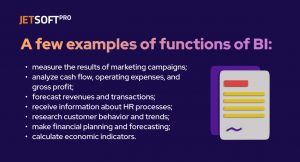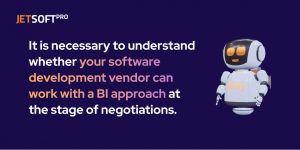Business Intelligence (BI) is the best IT solution to help organizations make more data-driven decisions. It is based on data and business analytics but uses it only as part of a process and turns raw data into meaningful information.
BI gives a complete view of the company’s data and transforms it into business insights. According to statistics, more than 50% of organizations consider data management a business asset. Usually, companies look for outsourced IT experts to work with data and make custom software.

Any company in any industry can apply Business Intelligence. Businesses should implement this IT solution for:
- integration of information from several sources;
- ensuring operational access to business data;
- providing access to information or analytics to a large number of users;
- introduction of new products;
- responding to updates in the IT environment;
- tracking the company’s activities in departments that were terra incognita;
- acceleration of the company’s growth.
The value of BI is evident. BI provides access to information critical to the success of finance, sales, marketing, and other departments. Understanding large amounts of data helps you make difficult decisions guided by knowledge, not intuition. Properly collected and analyzed data provides answers to 99% of questions.
Business Intelligence brings the company’s work to a new level. Constant data monitoring allows for making more thoughtful and timely decisions. Historical and current data availability helps build accurate forecasts for the business. Operational access of employees to analytics and operational data increases the quality of work and, at the same time, reduces labor and time costs.

How To Implement BI Approach Into Your Software Development Process?
Software development vendors can help collect large data sets and turn them into valuable business information. However, even a costly software development process can be streamlined with the BI approach.
Outsourcing software development is the best solution for staffing to IT teams for the following years. Outsourcing at startups is expected to grow 70% by 2023, with companies projected to outsource at least 36% of their software development positions.
Everyone who hires outsourced employees has a list of points to compare different vendors to choose the best one. We suggest adding an unusual item to this list. It is an approach to work. Here are the 4 most common among them.
- Traditional. The vendor does whatever the customer wants. “Everything” is limited only by the competency of the vendor.
- Advisory. The vendor takes the customer’s idea and advises on implementing it during the project.
- BI. Software development is split into iterations. Each iteration must be tested and qualified as useful for business or not. Next iterations are chosen based on the previous results to avoid over costs.
- Careless. The vendor operates within the client’s budget and vision and never suggests improvements.
What Is The Iteration, And How It Works?
The BI approach involves analyzing a software task and breaking down the large project into small subsections and iterations. In iterative development, feature code is designed, developed, and tested in repeated cycles.
Iteration must be tried on alpha and beta, i.e., on the market and with real customers. At each stage, the software is brought to the market and tested.
Initially, it has fewer functions and is given to users for testing and complaint. Next, data is collected, and the results of this collection are included in the next iteration. It is again tested in the market to improve the next version. The research continues throughout the development, so this approach is more prolonged and expensive. However, it is the most rational for business development.
It is much more responsible because you don’t have to rely on generalized market research. Also, you can forget about surveys and other slow data collection methods.

How to Set Up a Team for Software Development Based On BI Approach?
The developers in your company usually need to gain the necessary expertise. There is always an option to hire a vendor who will offer solutions that suits your business needs best and make architectural, technical, and strategic decisions.
Usually, there are four primary roles:
- The Head of BI has business and technological skills, generates insights, and drives BI implementation.
- BI engineer designs, builds, implements, and sets BI systems.
- Business analyst validates, process, and visualizes data, transforming the analytics into actionable insights.
- Data Scientist uses analytical, statistics tools, and machine learning to pull out actionable value from big data.
It is necessary to understand whether your software development vendor can work with a BI approach at the stage of negotiations.
- Highlight that you want to change the product according to the upcoming date.
- Check the cases where this approach was used earlier.
- Take your CTO or another competent person to the negotiations to ask narrow-focus questions.
How Much You Pay For BI-styled Software Development?
Before implementation, you must know the cost of BI-styled software development project. The price can be different because it depends on many parameters. JetSoftPro can help with the calculation.
The good news is that your project can earn from the first iteration. JetSoftPro knows how to make the project profitable from the beginning. At the start, we calculate which functions need to be added sequentially. Thus, we calculate each iteration’s return on Investment (ROI).
You will benefit from implementing Business Intelligence if you partner with a trusted software development provider to manage your business data and take advantage of the valuable insights it brings. JetSoftPro has experienced IT specialists who are ready to get to work. Write us for consultation and a discussion of details.

